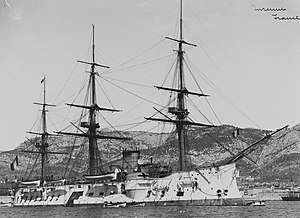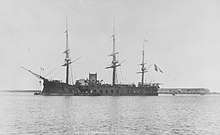French ironclad Turenne
Turenne was an ironclad barbette ship of the French Navy built in the 1870s and 1890s; she was the second and final member of the Bayard class.
 Turenne close offshore | |
| History | |
|---|---|
| Name: | Turenne |
| Laid down: | 1876 |
| Launched: | October 1879 |
| Completed: | 1882 |
| Struck: | 1901 |
| General characteristics | |
| Class and type: | Bayard-class ironclad |
| Displacement: | 6,260 long tons (6,360 t) |
| Length: | 81 m (265 ft 9 in) lwl |
| Beam: | 17.45 m (57 ft) |
| Draft: | 7.62 to 7.7 m (25 ft 0 in to 25 ft 3 in) |
| Installed power: |
|
| Propulsion: |
|
| Sail plan: | Full-ship rig |
| Speed: | 14 to 14.5 knots (25.9 to 26.9 km/h; 16.1 to 16.7 mph) |
| Crew: |
|
| Armament: |
|
| Armor: | |
Design
The Bayard class of barbette ships was designed in the late 1870s as part of a naval construction program that began under the post-Franco-Prussian War fleet plan of 1872. At the time, the French Navy categorized its capital ships as high-seas ships for the main fleet, station ironclads for use in the French colonial empire, and smaller coastal defense ships. The Bayard class was intended to serve in the second role, and they were based on the high-seas ironclad Amiral Duperré, albeit a scaled-down version.[1]
Turenne was 81 m (265 ft 9 in) long at the waterline, with a beam of 17.45 m (57 ft) and a draft of 7.62 to 7.7 m (25 ft 0 in to 25 ft 3 in). She displaced 6,260 long tons (6,360 t). The crew numbered 24 officers and 425 enlisted men. Her propulsion machinery consisted of two compound steam engines with steam provided by eight coal-burning fire-tube boilers. Her engines were rated to produce 4,400 indicated horsepower (3,300 kW) for a top speed of 14 to 14.5 knots (25.9 to 26.9 km/h; 16.1 to 16.7 mph). To supplement the steam engines on long voyages overseas, she was fitted with a full-ship rig.[2][3]
Her main battery consisted of four 240 mm (9.4 in), 19-caliber guns mounted in individual barbette mounts, two forward placed abreast and two aft, both on the centerline. She carried a pair of 190 mm (7.6 in) guns, one in the bow and one in the stern as chase guns. These guns were supported by a secondary battery of six 140 mm (5.5 in) guns carried in a central battery located amidships in the hull, three guns per broadside. For defense against torpedo boats, she carried four 47 mm (1.9 in) 3-pounder Hotchkiss revolver cannon and twelve 37 mm (1.5 in) 1-pounder Hotchkiss revolvers, all in individual mounts. Her armament was rounded out with two 356 mm (14 in) torpedo tubes in above-water launchers. The ship was protected with wrought iron armor; her belt was 152 to 254 mm (6 to 10 in) thick and extended for the entire length of the hull. The barbettes for the main battery were 203 mm (8 in) thick.[2]
Service history

Construction of Turenne began with her keel laying in March 1877 in Lorient;[3] her completed hull was launched in October 1879, and fitting out work was completed in 1882.[2] On 16 February 1884, Turenne was involved in experiments with marine gyroscopes at Brest.[4] The ship took part in a training exercise for naval reservists in mid-1891; around 3,700 men were called up to take part in familiarization training and Turenne was activated to participate, along with the coastal defense ships Vengeur, Tonnerre, and Tonnant. They did not participate in formal maneuvers, and each vessel went to sea individually to train their crews.[5]
In 1896, the contemporary journal The Naval Annual noted that the ship, along with the other station ironclads still in the French inventory, was "practically condemned" and would "shortly be struck off the list". She nevertheless remained in the navy's inventory as part of the 2nd category of reserve, along with several old coastal defense ships and unprotected cruisers. They were retained in a state that allowed them to be mobilized in the event of a major war.[6] The French government struck a number of old vessels from the naval estimates in 1899, removing funding allocated to keep them up.[7] Turenne was eventually struck from the naval register in 1901; her ultimate fate is unknown.[2]
Notes
- Ropp, p. 97.
- Gardiner, p. 302.
- Dale, p. 405.
- Proceedings, p. 528.
- Thursfield, p. 62.
- Weyl, pp. 88, 96.
- Brassey, p. 78.
References
- "Bibliographic Notes". The Proceedings of the United States Naval Institute. X (3): 521–528. 1884.
- Brassey, Thomas A. (1899). "Chapter III: Comparative Strength". The Naval Annual. Portsmouth: J. Griffin & Co.: 70–80. OCLC 496786828.
- Dale, George F. (1982). Wright, Christopher C. (ed.). "Question 23/81". Warship International. Toledo: International Naval Research Organization. XIX (4): 404–405. ISSN 0043-0374.
- Gardiner, Robert, ed. (1979). Conway's All the World's Fighting Ships 1860–1905. London: Conway Maritime Press. ISBN 978-0-85177-133-5.
- Ropp, Theodore (1987). Roberts, Stephen S. (ed.). The Development of a Modern Navy: French Naval Policy, 1871–1904. Annapolis: Naval Institute Press. ISBN 978-0-87021-141-6.
- Thursfield, J. R. (1892). Brassey, Thomas A. (ed.). "Foreign Naval Manoeuvres". The Naval Annual. Portsmouth: J. Griffin & Co.: 61–88. OCLC 496786828.
- Weyl, E. (1896). Brassey, Thomas A. (ed.). "Chapter IV: The French Navy". The Naval Annual. Portsmouth: J. Griffin & Co.: 73–101. OCLC 496786828.